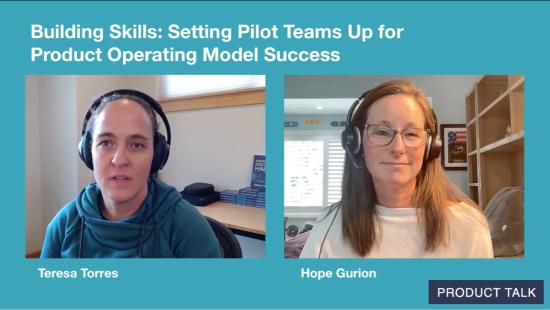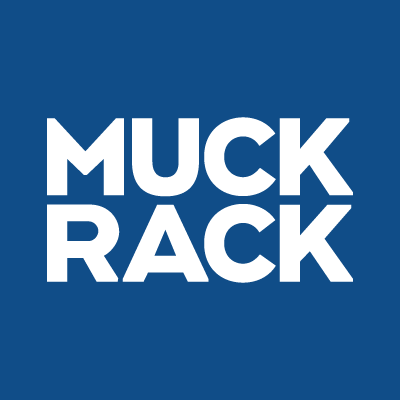Building Skills: Setting Pilot Teams Up for Product Operating Model Success
Change is exciting, but too much change can feel chaotic. When making a big change like adopting the product operating model or continuous discovery, how do you tap into the […] The post Building Skills: Setting Pilot Teams Up for Product Operating Model Success appeared first on Product Talk. Building Skills: Setting Pilot Teams Up for Product Operating Model Success was first posted on June 11, 2025 at 6:00 am.© 2024 Product Talk. Use of this feed is for personal, non-commercial use only. If you are reading this article anywhere other than your RSS feed reader or your email inbox, then this site is guilty of copyright infringement. Please let us know at support@producttalk.org.

Change is exciting, but too much change can feel chaotic.
When making a big change like adopting the product operating model or continuous discovery, how do you tap into the excitement while also controlling the chaos?
This is a question that Hope Gurion and I have been exploring over the past several months in our series on organizational change.
After working with hundreds of teams who are going through this transformation, Hope and I have seen firsthand which approaches tend to work and which ones are less likely to succeed.
If you’ve missed the other articles in this series, you might want to check them out first:
- First, we considered how to determine if your organization is ready for change.
- Next, we revealed the most common mistake we see companies making when they get started with their transformation.
- Then we shared advice on how to select your pilot teams.
In the most recent article, we took a closer look at pilot teams—how many is the right number? How do you go about selecting them?
We explored a few characteristics to look out for when selecting your pilot teams, including the relationships among the team members, their mindset and willingness to learn, and their access to customers.
In today’s conversation, we’re taking a closer look at what skills pilot teams need to be successful. As a leader, how can you create the right conditions that will help them become more outcome oriented?
You can watch the video of our discussion or read a lightly edited transcript below.
Full Transcript

Teresa Torres: Welcome everybody, I’m Teresa Torres and I’m here with Hope Gurion. We are recording the next installment of our org transformation video series.
In our last video, we dove deep on how to choose pilot teams. For today’s topic, we’re going to get into how you make sure your pilot teams have the support they need in terms of skills and what types of skills they’re going to have to develop to work this way.
Hope, do you want to give an overview of some of the things we’re going to talk through?
4 Necessary Skills for Becoming an Outcome-Focused Product Team
Hope Gurion: Most teams—when they are working in an outcome-oriented style of product management for the first time—are rusty or never have certain skills. And here’s some of the key signifiers:
- They usually don’t have sufficient business context.
- They’re not talking to customers regularly.
- They don’t have fast, effective methods to de-risk their decisions in terms of what to build.
- And they’re moving pretty slowly.
These are the skills that we want to help those pilot teams develop so that we get to those desired outcomes as quickly and effectively as possible.
Teresa Torres: I can’t emphasize this enough. We can’t just take a team and say, read the book, go work this way. All of these areas that you highlighted are hard skills that need practice and need to be developed.
So if you want your pilot teams to be successful, you need to find a way to upskill the teams in these areas.
Let’s dive into each of these one at a time.
I know you teach and designed our Defining Outcomes course. Do you want to talk about what you see in terms of just missing business context and what they need help with?
1. A clear understanding of the business context
Hope Gurion: A lot of teams don’t even know the basics about their company. And it’s not necessarily the team’s fault. It’s often because the leaders haven’t clarified. They’ve been communicating to their teams in terms of outputs—go build these things—and never spent any time educating the teams on the strategic context.
So what we teach teams to do is to clarify what the company’s desired business outcomes are and translate those into product outcomes. And again, something even as basic as understanding how your company makes money and how your product fits into that revenue formula is incredibly clarifying for teams. And many, many teams do not understand that business context.
Teresa Torres: I think it’s sometimes hard for product leaders to know that this is a problem. When we were going back and forth designing our Defining Outcomes course—both of us have executive experience. We know this stuff inside and out. We were worried our course would be too easy, because we literally start with: Revenue is price times quantity.
And what we hear from students regularly—even people in senior individual contributor roles—is that it’s all new to them. They’ve never been introduced to this business language. They don’t understand revenue. They don’t know how it’s calculated. They don’t know how their work contributes to it. And I think in an outcome-driven team, it’s really important they see how their work contributes to the business success.
Hope Gurion: It’s one of these things that teams don’t want to say out loud: “I don’t understand how our company makes money. I’ve worked here for ten years. I don’t understand how our company makes money.” So as a leader, don’t assume that your team knows how the company makes money.
Teresa Torres: And how their work contributes to it. So they might know, we sell software and they pay this much for it. And I can look at our pricing page, but they don’t know how what they’re working on contributes to generating revenue, reducing costs, or whatever it may be.
2. Regular customer conversations help us find the most important problems to solve
Teresa Torres: Okay, I think there’s two other areas that kind of go hand in hand, and I’m going to talk about it in the most generic sense, and then I’ll introduce how we talk about it.
So in the most generic sense, your teams need to learn how to uncover what problems to solve for their customers, and they need to learn how to evaluate if their proposed solutions actually solve those problems.
We talk about this in the context of customer interviews and opportunity mapping: We’re going to go talk to our customers to learn about their unmet needs, their unmet pain points, their desires.
And then we’re going to use opportunity mapping to synthesize all that and figure out what’s the most important problem to solve. And I think for a lot of teams, they’ve never done anything like this. Stakeholders have brought them solutions to build. And they’ve never had to think about who it’s for, what need it addresses, and whether it actually addresses that need. So this is a big area that we see a lot of skill development.
3. Evaluating if we are building the right solutions
And then the second piece, I think most of our teams are good at building solutions, but they may not be good at evaluating if they built the right thing. And so this is where in our Identifying Hidden Assumptions course and our Assumption Testing course, we get into how you deconstruct your ideas into their underlying assumptions.
How do you then run quick and dirty assumption tests that can still support decision-making? Not unreliable tests, right? Still tests that can support decision-making, but are quick. And I think both of these things help to really unlock the next item that you’re going to talk about around faster learning cycles.
4. Unlocking faster discovery cycles
Hope Gurion: A lot of teams that are learning to practice continuous discovery, again, the measure of success is: How much impact did we make on the outcome and how quickly can we make that? We don’t want to have these long cycles. We want to be able to learn quickly. And so certainly having weekly customer interviews, having the assumptions clear, and testing those in short timeframes is going to expedite progress towards the outcome.
And so teams are going to need to learn how to rightsize what they are doing to expedite their learning. That typically means we need to enable them with qualitative discovery skills and quantitative discovery skills. We need to make sure they have instrumentation so that they can learn both qualitatively and quantitatively to expedite their progress.
Teresa Torres: And both of those are so tied to, when you learn how to interview well, you can get qualitative feedback on what you built. And when you learn how to run good assumption tests, you can get quantitative feedback on what you’re building. And that just feeds into, okay, now we released it, can we measure impact? How are we learning quickly from this cycle?
A bonus 5th skill: Team collaboration
I think another big area that we often underestimate is just that teams need to learn cross-functional collaboration. We see this in all of our courses as well. We actually make our students work in teams. They first do the individual work, and then they come and negotiate the differences between their work as a team.
And I think a lot of people just don’t know how to do this. We see even executives don’t know how to do this. It’s why our executive leadership meetings can be so tough. We just need practice.
Somewhere along the line, your pilot teams, they’re going to storm. Every new team or every team going through a new kind of way of working is going to storm. And so how are you supporting them as they storm? And how do you give them good collaboration skills that they may not have been introduced to?
Hope Gurion: I think that’s one of the skills that people really benefit from because they’re used to doing all of that through long discussions. One of the skills that people benefit from in our courses is that ability to show your work, externalize your thinking, recognize where you have different expertise so that you can resolve those differences quickly. That, again, helps expedite progress.
Teresa Torres: I also think with practicing, the goal is to explore everybody’s perspectives and not advocate for my perspective. Just getting comfortable with that and knowing that when everybody does that, we’re all going to be heard and our group version is going to be better than our individual version.
Finally, navigating both discovery and delivery
Hope Gurion: I’d say the last thing that most people don’t really have is knowing when to move from discovery to delivery. And again, most teams don’t have the skills because they’ve only practiced delivery. Everything moves to delivery at one point or another. And how do we know when we’ve got enough evidence to make the decision we’re trying to make is another one of these skills that we teach, especially in Assumption Testing, because we want to think about what is the next decision we’re going to make based on the result of this test.
Teresa Torres: I think a big part of this—the intersection between discovery and delivery—also comes down to: How do we reduce our work in progress? How do we work on smaller things so we can ship more often?
And most people, they hear smaller things and they think low-hanging fruit. And that’s not what we mean. How do we work on those big, hard problems, but ship value incrementally?
And I think that’s also a skill that people need to learn. And it’s really rooted in opportunity mapping. You break down your opportunities into smaller and smaller opportunities, but also story mapping, starting with the most ruthlessly simple solution you can identify that still has the potential to address the target opportunity.
To learn more about reducing your work in progress see: Ask Teresa: Do Product Teams Really Ship Value Weekly?
Key Takeaway: If You Want Your Pilot Teams to Be Successful, Don’t Forget Training or Upskilling
Teresa Torres: So there’s a lot here. People don’t need to be overwhelmed. I think the takeaway here is: If you want your pilot teams to be successful, there is probably a training or upskilling component to that.
There are lots of ways you can do that. We, of course, offer a wide variety of courses we’d love for you to join us in. You can do it yourself as the leader if you have these skills, but you have to be prepared to put the time in. Your teams are not going to read a book and know how to conduct a good interview—or any of these other skills. There has to be a skill component to this that you’re really deliberate about.
Hope Gurion: And I think that’s why pilot teams work so well, because you give the opportunity for people to learn and practice the skills. And then you, as a leader, have a chance to observe where we need to further invest. Which ones did they really struggle with? And that’s where we want to spend our time coaching or training to help them get even better and faster with that skill.
Teresa Torres: I think also it gives leaders an opportunity to see where they themselves can help with training versus where they might need outside help.
Hope Gurion: Absolutely.
Teresa Torres: All right. This has been great. We will be back shortly with a video about what everybody else in the organization can expect to support our pilot teams. Until next time!
Hope Gurion: Bye!
Don’t miss the next video in this series. Be sure to subscribe below.
The post Building Skills: Setting Pilot Teams Up for Product Operating Model Success appeared first on Product Talk.
Building Skills: Setting Pilot Teams Up for Product Operating Model Success was first posted on June 11, 2025 at 6:00 am.
© 2024 Product Talk. Use of this feed is for personal, non-commercial use only. If you are reading this article anywhere other than your RSS feed reader or your email inbox, then this site is guilty of copyright infringement. Please let us know at support@producttalk.org.





















































































































































